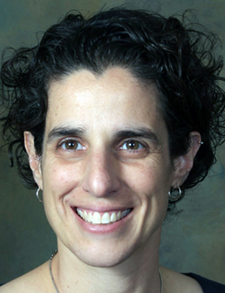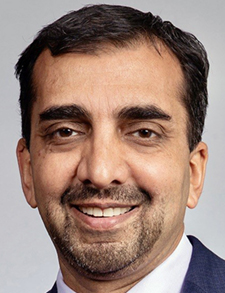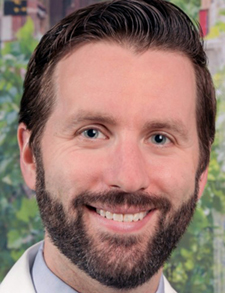 Severe cases of COVID-19 infections continue to necessitate hospitalization more than two and a half years after the pandemic first hit.
Severe cases of COVID-19 infections continue to necessitate hospitalization more than two and a half years after the pandemic first hit.
A total of 26,996 patients were hospitalized with COVID-19 in the U.S. as of Nov. 30, 2022, according to the Centers for Disease Control and Prevention’s COVID-19 Tracker,1 with a seven-day average of new deaths at 317 as of Nov. 16, 2022. This is down 5.3% from the previous seven-day average.
But in contrast to the panic, emergency response, and mobilization for the pandemic’s early stages and steepest surges, managing COVID-19 in the hospital today has become relatively straightforward, even routine, with a handful of recognized treatments that can be used by hospitalists. Questions and controversies more often are non-medical, reflecting politics, polarizing attitudes, and ongoing vaccination controversies.

Dr. Babik
Jennifer Babik, MD, PhD, professor of medicine in the division of infectious diseases at the University of California San Francisco, offered a straightforward review of the basic treatment strategies in her presentation, “Update on Inpatient Management of COVID-19,” at the Management of the Hospitalized Patient conference Oct. 13 in San Francisco.
COVID-19 management has become less complicated than it was a year or two ago, she said. “It used to be when a week went by, I’d have to change all my slides.” Now, Dr. Babik’s PowerPoint for her presentations on how to manage COVID-19 in the hospital can go unchanged for weeks or even months.
Some hospitalists make a distinction between patients hospitalized for COVID-19 or admitted with COVID-19, but Dr. Babik said these prepositions can be confusing. She prefers to say patients admitted for non-COVID-19 diagnoses but who are also COVID-19-positive. Their incidental COVID-19 infection might be mild enough that they otherwise could have received outpatient treatment for it, including oral medications. For such patients, the hospitalist might choose to view their inpatient management as providing typical outpatient COVID-19 therapies as if they were outpatients while they receive inpatient treatments for their admitting diagnosis.
Nirmatrelvir/ritonavir (Paxlovid), an oral antiviral granted emergency use authorization from the U.S. Food and Drug Administration in December 2021, consists of two generic medications, nirmatrelvir, a protease inhibitor, and ritonavir, an antiviral medication for HIV. It’s used for outpatient treatment of mild to moderate COVID-19 in adults and children aged 12 and up.
Remdesivir, a direct-acting nucleotide prodrug inhibitor approved by the Food and Drug Administration for patients at high risk of severe COVID-19 in October 2020, is the antiviral most typically used in the hospital for COVID-19.
The first week of the illness is the viral phase, treated with antiviral therapies, Dr. Babik said. The second is the immune or inflammatory phase, treated with immunomodulators. But there is a lot of overlap between these categories. She recommends the National Institutes of Health’s Guidelines on Therapeutic Management of Hospitalized Adults with COVID-19.2
Two immunomodulators, tocilizumab, an immunosuppressive drug used for rheumatoid arthritis, and baricitinib, a JAK inhibitor, given intravenously and orally, respectively, are recommended only for patients on oxygen who are rapidly worsening or who are on high-flow nasal cannula, noninvasive mechanical ventilation, or mechanical ventilation.
“We usually mostly do standard tests,” Dr. Babik said, sometimes including a CRP (C-reactive protein) test to identify the level of inflammation caused by severe infection. All COVID-19 patients should have a baseline chest X-ray, but a chest CT is not needed routinely unless there is concern for an additional process. She also recommends checking for drug-drug interactions and whether anticoagulation is indicated if using a drug like Paxlovid, and watching out for long COVID-19.
Endemic, almost routine

Dr. Tirupathi
“Things have changed a lot over the last two years from the dark early days of the pandemic, when you were seeing so many patients dying in front of you,” Raghavendra Tirupathi, MD, FACP, FRCP, FIDSA, medical director of Keystone Infectious Diseases in Chambersburg, Penn., and chair of infection prevention at Wellspan Chambersburg and Waynesboro hospitals, said.
“Now the disease is more of an outpatient phenomenon, with more patients treated within the first five days of symptoms with oral medications, and with decreasing numbers of hospitalizations. That has brought back some normalcy for some of us so that hospitalists can focus on other clinical conditions. We are cautiously optimistic but need to stay prepared for what comes next,” he said.
What hospitalists worry about most is another surge that could once again stretch hospital capacity. There are still substantial numbers of patients hospitalized for COVID-19, predominantly the unvaccinated, very elderly, or immune-compromised. People are still dying of COVID-19 every day, Dr. Tirupathi said. Hospitalists need to be aware of the treatment options, not only for severe COVID-19, but for management of mild-to-moderate cases and the risk for progression to severe COVID-19.
He also emphasized the opportunity for hospitalists to have informed discussions with hospitalized patients about the COVID-19 vaccine. “Know the reasons for their reluctance and offer to start a vaccine series in the hospital. Sometimes you can start a conversation that leads to action down the road,” he said. “We want to take every opportunity for it.”

Dr. Ansari
Aziz Ansari, DO, FAAHPM, FACP, SFHM, associate chief medical officer at Loyola University Medical Center in Maywood, Ill., said his hospital is seeing fewer cases of COVID-19 respiratory failure. “So yes, COVID-19 is changing. I still oversee COVID-19 clinical operations, but I’ve stopped reviewing every COVID-19 case that comes through here. We used to have COVID-19-specific multidisciplinary rounds, and we don’t do that anymore,” he said.
COVID-19 has become endemic, almost routine. “It’s not going away, and we’re living with it. But I don’t see masks coming off clinicians in our hospital anytime soon—if ever.” It is still standard practice to test every new admission for the virus, and those who are positive still need to be isolated. But COVID-19 cases aren’t localized at a designated part of the hospital anymore, he said. “They could be in any part of the hospital except the bone marrow unit.”

Dr. Mehta
For Swati Mehta, MD, CPXP, FACP, SFHM, the national director of quality and patient experience for Vituity, a physician-led health care innovation company based in Emeryville, Calif., and a practicing hospitalist at Dignity Sequoia Hospital in Redwood City, Calif., the pandemic’s impact is far from over.
“Because many patients with other chronic conditions resisted seeking medical care during the pandemic, many of them are now presenting with worsening symptoms. When they seek care, it raises acuity levels in our hospitals. We are often at full capacity, with scarce real estate, and a higher acuity than before the pandemic. We struggle to see such high patient volumes, and it’s harder to transition patients with COVID-19 to skilled nursing facilities,” she said.
Hospitalists are also doing vent management and other ICU-level care and are asked to do tele-critical care, tele-evaluations, and tele-admissions, she said. In the post-COVID-19 era, they will need to be agile for these new and different roles. “It has reached the point where the emergency department and hospital medicine are virtually the same team. We need to be close collaborators.”
All these demands mean increased stress and burnout for clinicians, she said. “If another surge comes, we won’t have rested because of the continuing high census. We never got a respite. But we’ve learned, and we’re better prepared.”
Are hospitalists following the guidelines?

Dr. Kubey
Alan Kubey, MD, FACP, is the corresponding author of a study published in April in JAMA Open Network,3 based on a December 2020 survey of hospitalists at more than 50 major academic medical centers asking if their institutional policies or protocols were aligned with accepted best clinical practice guidelines or research findings for COVID-19 treatment. It concluded that at that time, most were doing an impressive job of translating the best available evidence and pivotal controlled trials into clinical guidelines.
But the survey did not address whether these recommendations were reaching the bedsides of hospitalized patients, or how frontline clinicians such as hospitalists were actually practicing them. Dr. Kubey, a hospitalist at Thomas Jefferson University Hospital in Philadelphia, Penn., and at Mayo Clinic in Rochester, Minn., is a member of the HOMERuN (Hospital Medicine Reengineering Network) COVID-19 Collaborative Group, which conducted the survey. He wonders how effectively today’s routine best practices and recommendations from NIH and others are shaping clinicians’ practice.
Doctors are burned out and tired of the COVID-19 crisis, he said. “A lot of us have gotten numb because the fire alarm has gone on for so long.” Plus, doctors are trained to appraise evidence and expert recommendations critically and skeptically. And the drugs and vaccines used today were most rigorously studied for earlier variants of the SARS-CoV-2 virus.
“We haven’t seen the same level of compelling new evidence on vaccines or immunity since the Delta variant. What works in theory may not work in trials. We still should be doing ongoing, real-world trials, but there’s fatigue for COVID-19 clinical trials, as well,” Dr. Kubey said.
“I believe there are doctors out there who are thinking, ‘Hey, you’re basing the recommendations on old data, and the newest data is real-world but not RCT [randomized controlled trial], so I have some questions. I need to see more nuanced recommendations.’” And the best physicians know that guidelines are not mandates. Care must be tailored to the individual right in front of them. “This is all further complicated by members of the medical community thinking or hoping that the pandemic is over. Does such a lack of focus lead to rationalizing under- or over-treatment at the bedside of COVID-19 patients?”
For most patients, the guidelines offer the best available evidence and best strategy, he said. “How do we get those guidelines to the bedside, with helpful support tools, just-in-time knowledge, and clarity of messaging, to ensure that the recommended treatment strategies are reaching COVID-19 patients? How do we make it easier for frontline clinicians to choose what’s best?” Dr. Kubey posed.
“I truly hope this winter will be considerably better than the last two. But I worry that many in our community are going into the winter with our heads in the sand.” Every time the virus has been underestimated in the past, he said, there was a steep price to pay.
Larry Beresford is an Oakland, Calif.-based freelance medical journalist specializing in hospice and palliative care, and a long-time contributor to The Hospitalist.
References
- Centers for Disease Control and Prevention. COVID Data Tracker. CDC website. https://covid.cdc.gov/covid-data-tracker/#new-hospital-admissions. Accessed November 30, 2022.
- National Institute of Health. Therapeutic management of hospitalized adults with COVID-19. National Institute of Health website. https://www.covid19treatmentguidelines.nih.gov/management/clinical-management-of-adults/hospitalized-adults–therapeutic-management/. Published August 8, 2022. Accessed December 1, 2022.
- Berger AC, et al. Implementation of clinical practice guidelines for hospitalized patients with COVID-19 in academic medical centers. JAMA Netw Open. 2022;5(4):e225657.